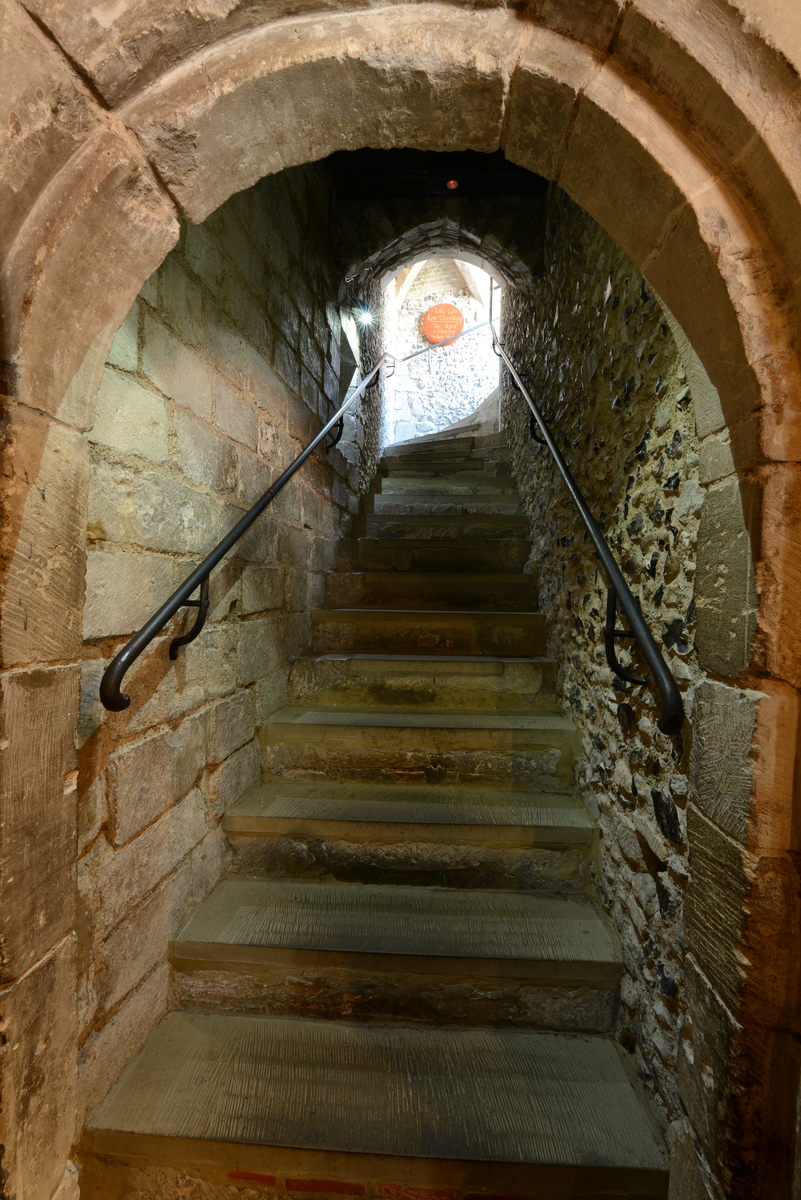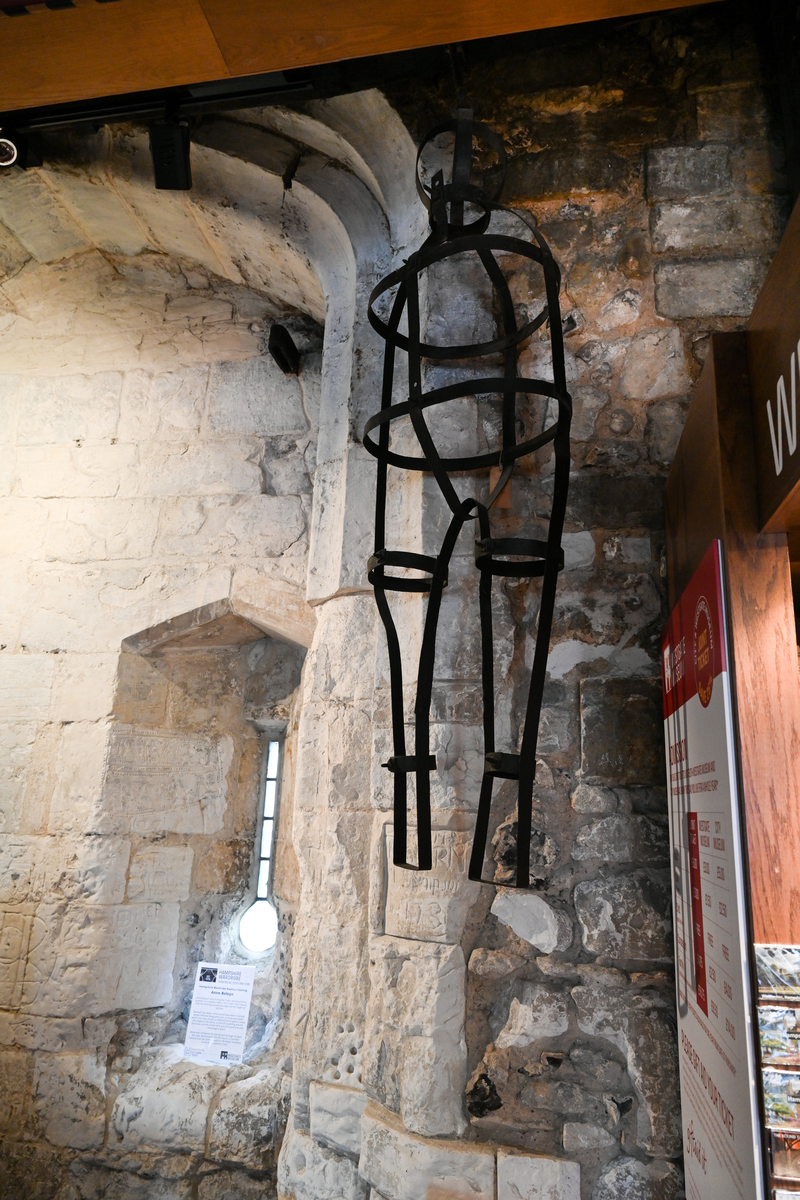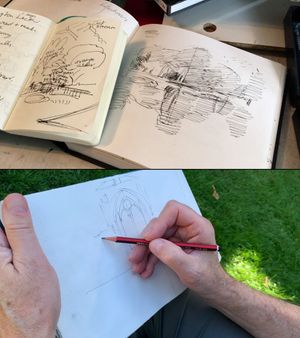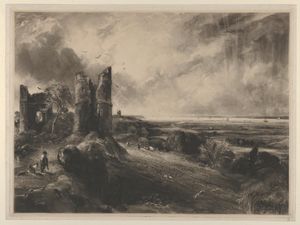The Westgate gibbeting irons
If you go to the Westgate Museum and walk up the steps to the upper chamber you will soon find yourself face-to-face with one of the more macabre objects in the trust’s keeping. Hanging from the ceiling next to the space where the portcullis once hung is a cage – a cage that seems to be forged into the shape of a human body.
Gibbeting was once the practice of displaying the executed or dying corpses of criminals as a public deterrent against further criminality. It was most frequently used for traitors, pirates, highwaymen, murderers and sheep stealers. To create such a deterrent, gibbets were most often placed at the side of roads or at crossroads and next to waterways. In many cases, the body would be coated in tar or wrapped in chains in order to prolong decomposition, left to the elements and wildlife until this process was complete, at which point their bones would be scattered.


The gibbeting irons in the Westgate Museum have hung in place since the museum’s opening in 1898. By tradition, these irons were used to hang the body of James Aitken, alias “John (or Jack) the Painter” at Blockhouse Point at the entrance into Portsmouth Harbour.
James Aitken was born in Edinburgh 28 September 1752. As a youth, he was briefly apprenticed as a housepainter before beginning a life of crime as a highwayman, shoplifter, thief and housebreaker. After several years of this, he experienced an epiphany, determining to destroy royal dockyards around the country to cripple the Royal Navy during the American War of Independence and ensure an American victory. His chief motivation seems to have been glory, ensured immortality and the heroic status conferred by a grateful new nation.
He travelled to France to have his plot approved by Silas Deane, a representative of Congress stationed there to gain French support, and subsequently believed that he had the backing of the American Revolutionary Government.
After creating a design for a time delayed firebomb and having several made in Canterbury, he attempted to light one in the rope house of Portsmouth Docks 7 December 1776. He was partially successful, managing to set fire to the building and escaping. Unfortunately for him, his plans were foiled by quick thinking on the part of the few remaining workers, and the blaze was brought under control.
But he had been seen, as he had managed to get locked inside the yard the day before and had to be released, thereby creating witnesses to his appearance, accent and alias! Sometime later, after semi-successful attempts to burn down both Plymouth and Bristol docks, another of his devices was discovered intact elsewhere in Portsmouth yard, sealing his fate. After his description was circulated, he was arrested at the Raven Inn in Hook in northeast Hampshire and remanded in Odiham Gaol.

His trial took place in the Great Hall in Winchester on Thursday 6 March. Aitken pleaded not guilty, hoping that the lack of concrete physical evidence would save him, but unbeknownst to him, he had been betrayed by a confidant and his confessions were taken in court as fact.
Sentenced to death, he was taken back to Portsmouth and on 10 March 1777, executed by hanging from the mizzen mast of the ship Arethusa.
Once dead, Aitken was cut down, placed in a gibbet whilst still in chains and then rowed out to Blockhouse Point to be hung as a stark warning at the harbour entrance. What happened to his body subsequently remains unclear.
A preserved finger, supposedly Aitken's thumb, was used in a dockside pub as a pipe stopper and survived into the twentieth century as part of Portsmouth City Museum’s collection before being destroyed by German air-raids during the Second World War.
However, it is highly unlikely that these particular irons were used to gibbet John the Painter at all. A letter from the Winchester city librarian from 1927 confirms that the Westgate gibbet irons have no sign of weathering that might be expected from many years of exposure to the elements and that the rivets extant upon them would not have been in use in 1777. There is also the question of how any gibbeting irons would have found their way back to The Westgate from Blockhouse Point in Portsmouth.
An old label records that the irons were given to the museum in 1890 by the Prison Commissioners in Winchester, though no gibbetings would have taken place there either. Thus, the question remains: is the entire story surrounding the irons the result of an overactive imagination on the part of nineteenth century curators?
I think that the last word on the matter should go to the little boy who touched the irons and then reacted with horror when I told him what they were used for. “Has it been disinfected?!”
With special thanks to William Smith, Visitor Experience Assistant, Winchester City and Westgate Museum, for contributing this article.




